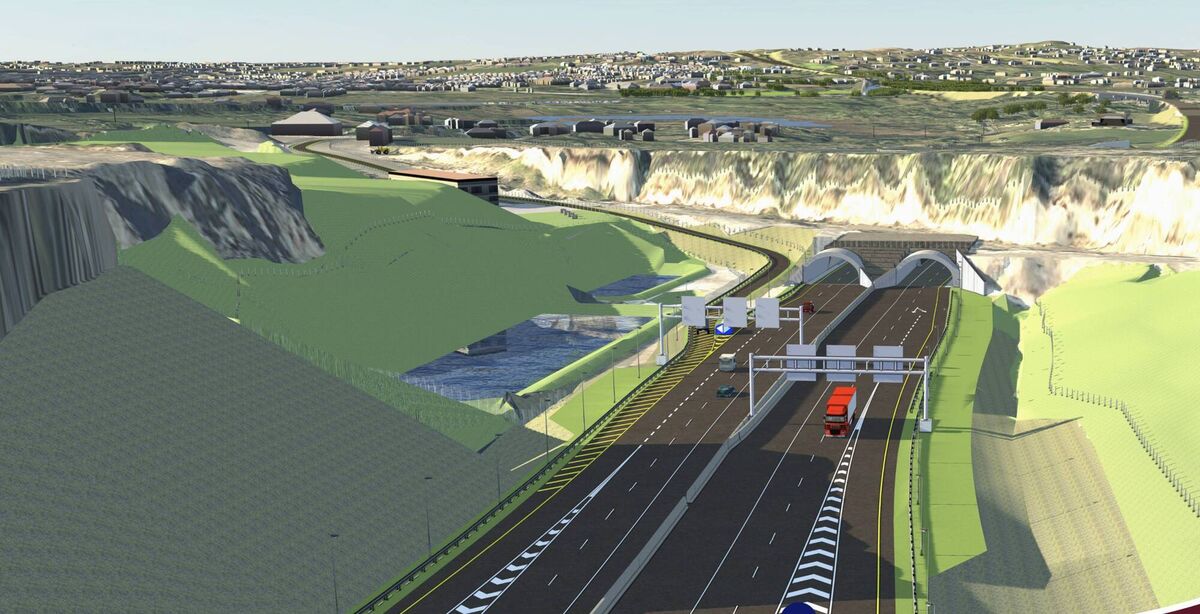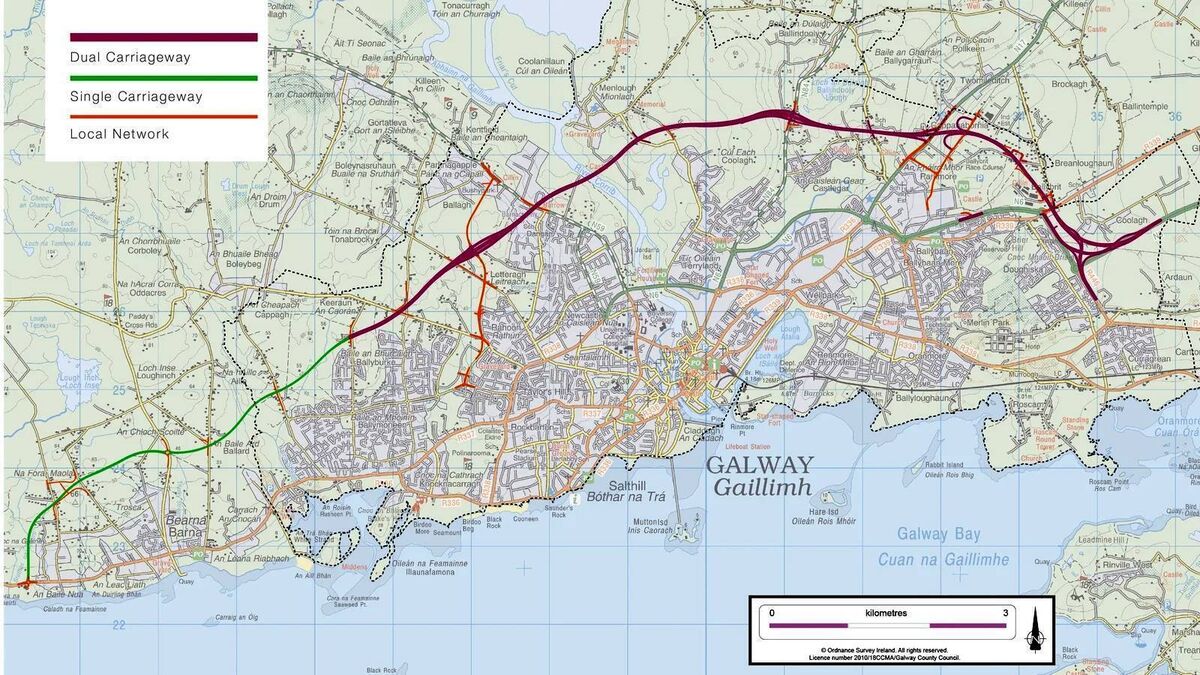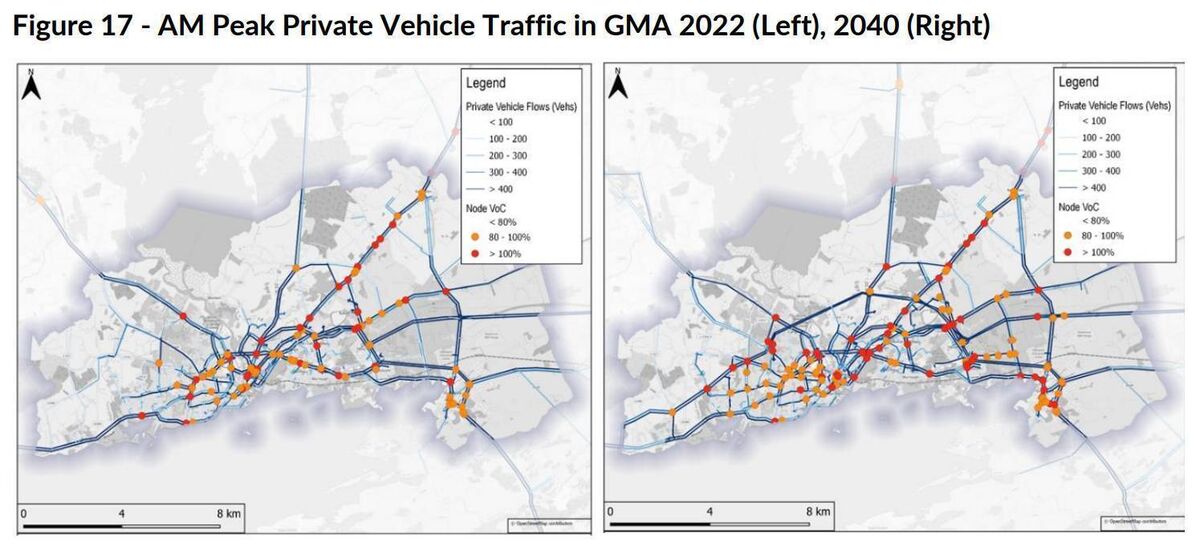New roads mean more traffic, not less — somebody should tell Galway County Council

A Department of Transport report on the Economic Cost of Congestion in Regional Cities predicts that Galway's ring road will experience heavy traffic flows and that the 'overall level of congestion in the city will rise given the higher volumes of vehicles on the road'. File picture
Even the most casual observer of our transport failings as a nation will be aware of Galway's atrocious traffic problems.
Along with the notoriety of the Cork to Limerick road, recently covered in these pages, the running joke of the city of many roundabouts and its LA-style traffic jams is synonymous with our seemingly intractable planning problems. The saga of the Galway City Ring Road plan is just another punchline.
Galway County Council’s latest planning submission on the Galway City Ring Road calls into question the plan's viability. It will bring increased congestion on many city streets and on commuter routes into the city. It will increase car use in the city and reduce the mode share for public transport, walking and cycling, and all of that to serve the 1% of Galway traffic that is actually bypassing the city.
38 years ago this year, the Quincentennial Bridge in Galway was opened to the public amid much fanfare. It was the first new crossing of the river Corrib since the Galway to Clifden Railway opened in 1895 and promised to take Connemara-bound traffic out of a congested city centre.
Despite this promise, five years later councillors in the then Galway Borough Council felt the need to establish a Transportation Committee to address continuing congestion in the city centre.

The phenomenon of induced demand, that is the propensity for new roads to generate increased traffic, had been known to traffic engineers for several decades prior to that and Galway was beginning to see its impacts first hand.
By 1999, the council had published the Galway Transportation and Planning Study recommending a second bypass for the city. It also recommended an improved bus service, the introduction of park-and-ride facilities, a new town of 20,000 people at Ardaun, and a demand responsive rural bus service – all to be delivered at a cost of £169 million (€215 million).
Twenty-six years later, none of these measures has been delivered and the price tag for building just the bypass element of this plan is now estimated to be about €1 billion.
The intervening years have seen a singular focus on delivering a second bypass, to the detriment of all other recommendations of the plan. In that time, we have seen two failed planning applications, two High Court cases, one Supreme court case and one case at the European Court of Justice. And the saga is not over yet.
The government has already spent approximately €45 million on the project with nothing to show for it. But this cost is not just the money that has been spent – there is also an opportunity cost.
That’s €45m that hasn’t been spent on improving the bus service in Galway, or in expanding the rail service, or building cycling infrastructure that would allow children to cycle safely to school and free parents up from the school run.
Last month, Galway County Council made yet another submission to An Bord Pleanála in the latest attempt to build what is touted as essential infrastructure for the development of Galway. It follows the High Court decision in 2023 to overturn the planning permission granted by An Bord Pleanála in 2021.
The current Transport Strategy for Galway City, which underpins the case for the ring road, is now almost 10 years old. Work on a new plan, the Galway Metropolitan Area Transport Strategy (GMATS) started in 2022, and its publication has been “imminent” for at least two years now.
You might expect that this document would be considered important in the assessment of the proposed ring road, but we have learned in the past week that its publication has been paused pending a decision by An Bord Pleanála on the revised submission from Galway County Council.

The reasons for this delay are unclear but it suggests a great deal of political wrangling behind the scenes between those that insist the ring road be part of any new strategy and those who see it for the colossal waste of money that it is.
In any case, it looks likely that Galway won’t see a new transport strategy for at least another two years and potentially longer if past experience of legal challenges is anything to go by. This leaves Galway at a significant disadvantage to the other four cities in Ireland which have all had updated transport strategies completed in the last five years.
Also in the past week, the Department of Transport has published a report on the Economic Cost of Congestion in Regional Cities. In its section on Galway, it predicts that the ring road will experience heavy traffic flows and that the “overall level of congestion in the city will rise given the higher volumes of vehicles on the road”.
Significantly, this increase in congestion won’t just be at peak times but will extend throughout the day. This will increase the cost of doing business in Galway as goods vehicles which currently take advantage of lighter traffic during the daytime will now be unable to avoid the congestion.
So, what have we learned from the most recent submission to An Bord Pleanála?

One line in the revised Environmental Impact Assessment stands out: “The Project is predicted to result in a permanent moderate adverse effect on climate, which is considered to be significant”.
This statement is important because the reason the High Court overturned the 2021 decision was a failure by the board to take account of the most recently published Climate Action Plan.
The submission also gives updated figures for the traffic impacts on the city that the new road will bring.
While the data shows that there will be improved traffic flow on the existing bypass route, it also shows that there will be increased peak morning traffic flow on many of the main arterial routes into the city including the Tuam Road, Headford Road, Moycullen Road, Letteragh Road, Rahoon Road and the Western Distributer Road.
There will also be increased traffic on many roads within the city itself including quieter residential streets and streets with schools on them.
The documentation also looks at existing traffic patterns across the city which indicate that 57% of all private car trips take place entirely within the city boundary, trips that could, and perhaps should, be taken by public transport, cycling and walking.

Even more surprisingly, just 1% of trips are actually bypassing the city, the remainder are travelling into or out of the city. It's hard to see how spending €1 billion to accommodate that 1% of trips represents good value for money.
Thirdly, the document reports on the expected change in mode share after the road is built. Incredibly, it shows an increase in the percentage of trips taken by private car and a reduction in the mode share for public transport, walking and cycling.
So, we’re going to have more cars on the road, increased congestion over a longer period during the day, and no shift to more sustainable modes of transport. Is this really what we want for Galway?
Are we really going to spend €1 billion euro for a project that fails so spectacularly to deliver on the promise of a functioning, sustainable transport system for the city?
Thankfully there has been some progress on the public transport front in recent years led by the National Transport Authority who have expanded the Local Link service, are heading the BusConnects project, and have produced a feasibility study which makes the case for light rail in Galway.
The Local Link improvements have already started to have an impact on travel patterns within the city and environs.
In addition, a demand management study published in 2022 by the Department of Transport makes recommendations for measures that will reduce the demand for private car transport within the city.
The All-Island Strategic Rail Review, published in 2024, makes recommendations for improving rail connectivity to and from the city, and there are several plans in (slow) progress for cycling and walking routes in and around the city.
Galway City Council and the Land Development Agency are also developing high density residential communities in the city centre which will be less car-dependent than the low-density suburban development that characterises much of the city.
These initiatives and measures point the way towards a more sustainable transport future for Galway that breaks the cycle of car-dependency. The people of Galway have suffered too much from the mistakes of the past. After 26 years of pursuing the wrong solutions, they deserve better.
- Ciarán Ferrie is an architect and transport planner.
CLIMATE & SUSTAINABILITY HUB





